Cleaning and Preserving Nautical
Brass
by Bob Brooke
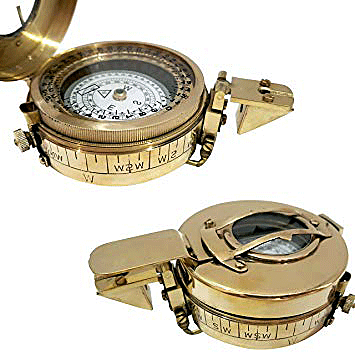 If
you collect antique nautical brass, you most likely want to keep it
looking its best. You can learn to restore and clean your pieces
without damaging them but get it wrong and your brass pieces can
rapidly lose their value. If
you collect antique nautical brass, you most likely want to keep it
looking its best. You can learn to restore and clean your pieces
without damaging them but get it wrong and your brass pieces can
rapidly lose their value.
The first thing you need to determine is whether the item you wish
to clean is, indeed, brass. Though it may look like solid brass, it
may in fact be brass-plated steel, zinc, or cast iron. The easiest
way to check? Place a small magnet on the metal. Magnets will not
stick to solid brass. So if the magnet sticks, the piece is
brass-plated. Plated items can be cleaned with hot soapy water, but
rubbing or polishing them too aggressively can remove the brass
plating, so proceed with caution.
Cleaning Antique Nautical Brass
There are numerous ways to clean solid brass. Your approach depends
on how dirty your pieces are and the amount of tarnish that has
built up. If your piece is solid brass, a simple buff with a
jeweler’s cloth will remove most mild tarnish. But if its really
dirty, begin by washing each piece with hot, soapy water and a
microfiber cleaning cloth: Go over all of the surfaces thoroughly
with the cleaning cloth, using a clean toothbrush to get into any
crevices. Rinse with warm water and dry thoroughly.
For tougher cleaning jobs, fetch the ketchup from the cupboard.
Simply rub a thin coat onto the brass, let sit for an hour or so,
then rinse the piece with hot, soapy water.
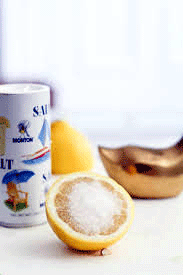 An
alternative natural cleaning combination is salt and lemon. Cut a
lemon in half and remove the seeds. Coat the cut half of the lemon
with table salt and rub it over the surface of the brass, re-coating
the lemon with salt as needed. Once you’ve covered the entire
surface, buff to a shine with a clean, dry cloth. An
alternative natural cleaning combination is salt and lemon. Cut a
lemon in half and remove the seeds. Coat the cut half of the lemon
with table salt and rub it over the surface of the brass, re-coating
the lemon with salt as needed. Once you’ve covered the entire
surface, buff to a shine with a clean, dry cloth.
Plain toothpaste, without any mouthwash or other additives, will
also work well. An old, clean toothbrush will help you reach any
small crevices where dirt and tarnish often collect. When applying
the polish, wear cotton gloves to avoid canceling out your polishing
work by leaving fingerprints. Apply the paste to your item with a
clean, soft, cloth. Once the piece is covered, rinse the paste away
and buff your piece with a separate cloth until it achieves a
brilliant, rich shine.
Above all, avoid using highly abrasive scrubbing cloths,
metal-bristled brushes, or steel wool, all of which will scratch the
surface of the brass.
To prevent tarnishing, you can then apply a thin coating of linseed
or mineral oil to the clean brass with a soft terry towel or a white
cotton athletic sock.
Removing Lacquer from Antique Nautical
Brass
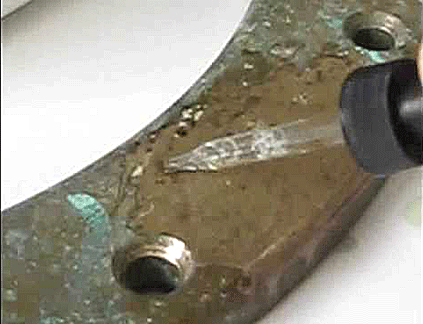 Some
pieces of antique nautical brass may have a protective lacquer
finish. These should only be cleaned with hot, soapy water. You can
remove the lacquer in several ways. First, heat up some water until
you can just bear it on your hands and then pour it over the piece.
If the lacquer is thin, you should be able to peel it off while it’s
hot. Failing that, try nail polish remover or denatured alcohol,
both of which should be effective since most lacquers have an
acetone or alcohol-soluble resins. Some
pieces of antique nautical brass may have a protective lacquer
finish. These should only be cleaned with hot, soapy water. You can
remove the lacquer in several ways. First, heat up some water until
you can just bear it on your hands and then pour it over the piece.
If the lacquer is thin, you should be able to peel it off while it’s
hot. Failing that, try nail polish remover or denatured alcohol,
both of which should be effective since most lacquers have an
acetone or alcohol-soluble resins.
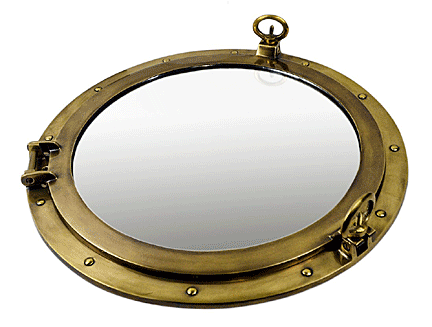 If
lacquered pieces are heavily tarnished, you’ll need to remove the
lacquer with a paint or varnish remover. Then you’ll need to clean
and polish the brass using one of the above techniques. You can then
choose to lacquer the piece again or leave it without. If
lacquered pieces are heavily tarnished, you’ll need to remove the
lacquer with a paint or varnish remover. Then you’ll need to clean
and polish the brass using one of the above techniques. You can then
choose to lacquer the piece again or leave it without.
Once you clean and polish your nautical brass, you should avoid
touching it as much as possible, as the oils in your skin can hasten
tarnishing. Regular cleaning and polishing with a microfiber cloth
will help keep dust and dirt from accumulating and keep your brass
looking lustrious.
Restoring Badly Tarnished Pieces
Restoring and cleaning antique nautical brass generally involves
removing dirt and oxidation and then protecting it from further
oxidation. If your brass has been neglected for years, then first
soak it in undiluted household ammonia or vinegar for an hour. But
don’t overdo it because the caustic ammonia will attack the
oxidation, dirt and grime, as well as the metal, so that any light
engraving might be reduced or even lost.
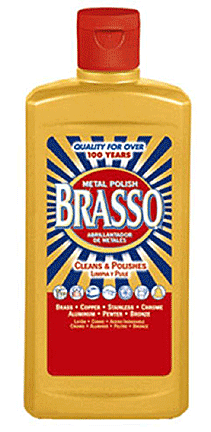 Light
tarnishing responds well to the ammonia in many commercial metal
polishes such as Brasso. They also remove dirt. Don’t hold back
because you won’t damage brass by rubbing hard. Light
tarnishing responds well to the ammonia in many commercial metal
polishes such as Brasso. They also remove dirt. Don’t hold back
because you won’t damage brass by rubbing hard.
Maintaining Your Antique Nautical Brass
After you have cleaned your brass, simply leave it. Do not keep
cleaning it whenever it loses its shine because you are liable to
leach the copper out to the top, and that will then be oxidized to
the greenish color (verdigris) of copper oxide that most pure copper
items revert to when left open to the air. A light spraying with
lacquer can help to protect your pieces while giving them a natural
look.
If you have valuable pieces of antique nautical brass that you have
collected for investment, you should not clean the brass finish.
Experts consider any removal of the patina undesirable—it’s the same
as removing the finish of 200-year-old furniture. Removing the aged
finish can greatly devalue your antique.
<
Back to Caring for Your Collections
Archives
Next Article >
|
